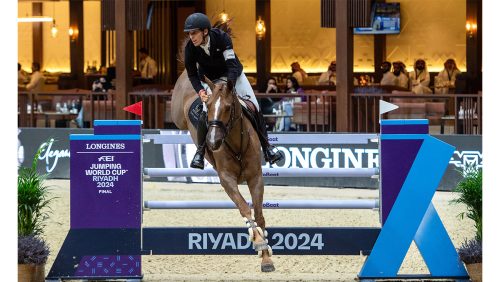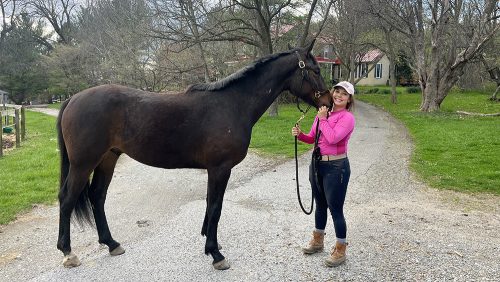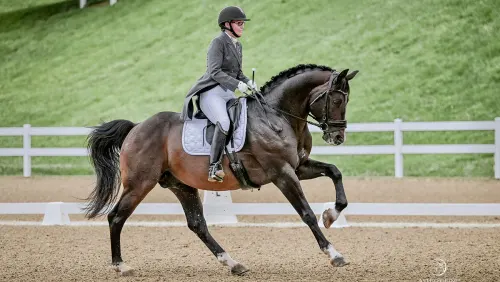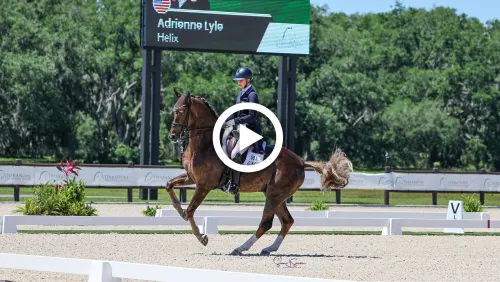When Katherine Bateson-Chandler heard the results of the Grand Prix on Feb. 17, she thought she’d finished second (69.51%) behind George Williams and Marnix (70.06%) at the Zada Enterprises, LLC Florida Dressage Classic in Wellington, Fla., Feb. 16-19. It wasn’t until she was driving out of the show on Saturday that she realized there’d been a mistake.
“I’d had such a busy day on Friday that I didn’t have time to pick up the test until Saturday,” said Bateson-Chandler, who rides FBW Kennedy for owner Jane Forbes Clark. “I was driving and looking at the test and adding it up in my head. It seemed like all the scores were above 70 percent, so I went back to the barn, got a calculator and added the scores up myself.”
As it turned out, the scores were averaged wrong. When the average was tallied correctly, Bateson-Chandler (70.20%) narrowly edged out Williams and Marnix for the win.
“I was so excited and happy when I realized the mistake. I feel like we come in second quite a lot, so it was great to be able to tell Jane that we had won,” said an exuberant Bateson-Chandler.
In May of 2005, Bateson-Chandler took over the ride on FBW Kennedy, or “Turbo,” after six-time Olympian Robert Dover retired. When Dover and Clark were looking for a replacement rider, Bateson-Chandler, who’s been working for Dover for 14 years, jumped at the opportunity to show the 16-year-old Baden-Wurttemberger.
“I’ve had the advantage of taking care of Turbo since he came to the States a few years ago, so I know him really well,” said Bateson-Chandler, who’s spent quite a bit of time on the chestnut gelding’s back. “I’ve paid my dues over time, and I’ve been hoping to be the next in line to show Turbo.”
Fine Tuning
Despite riding Turbo in the past, Bateson-Chandler insisted that in the show ring, it “takes awhile for a partnership to click.” But it seemed that all the right buttons were pushed after she finished her test on Friday.
“I was quite happy with the test because I’ve struggled with the changes over the past few months, and this time I made no mistake. I had one slip-up in the zigzag when my body got ahead of my brain,” she admitted.
“I’m not as experienced as Turbo is, so it’s been a balancing act between him trying to teach me how to ride him and me controlling my ride,” she explained. “I haven’t had the opportunity to show a lot in the past; I’ve just been waiting in the wings for Robert to retire.
“I just want to continue to be consistent and get as much experience as I can and make Robert and Jane as proud as I can,” insisted Bateson-Chandler.
Charlotte Bredahl Baker also focused on the consistency of her performance on Eskada. As a result, the pair went home with top honors in the Intermediaire I.
“I was hoping to do well but wasn’t expecting it,” said Baker, who rode the gelding to three second-placed finishes–in two open Prix St. Georges tests (68.00%, 68.00%) and Sunday’s Intermediaire freestyle (71.58%) after winning Friday’s Intermediaire I (71.62%).
ADVERTISEMENT
For many competitors, the Palm Beach Polo Equestrian Club is a difficult place to compete because of the commotion, but Baker prepared for the show in advance. She brought Eskada to the Wellington Dressage show, held Feb. 2-5, but did not compete him. She just wanted him to see the grounds and spend time up at the rings.
“I rode him around the grounds the first time so he wouldn’t be under pressure to show the first time,” said Baker, who added that the 9-year-old Dutch Warmblood was “scared the first time, but not crazy, just very looky and afraid of the jumping horses.”
To help cope with Eskada’s timidity and sensitivity, Baker rides him a few hours before competing to take some of the edge off.
Overall, Baker’s pre-show preparation paid off. Although Eskada did spook in his first extension during Thursday’s Prix St. Georges, Baker said the horse rode great.
“I felt that Friday’s Intermediaire I was overall the best ride. He is an elegant, uphill horse, and the judges like him because of his presence, so when he goes well, he usually gets high scores,” explained Baker, who said that Eskada’s canter work and pirouettes are his strong points.
Hard Work Never Ends
Even though she was pleased with Eskada’s performance, Baker stressed the importance of hard work and repetition in training.
“There’s still lots of detail work to improve on that never ends,” she said. “At home, we’ll keep working on his strength and creating more power. Eskada has good talent for collection, but it takes time. We need to spend more time working on halts and fine tuning.”
Baker, of Solvang, Calif., owns half of Eskada with Sayoko Nakatani of Japan. A year and a half ago, Nakatani, who was living in Hawaii at the time, sent the horse to Baker for training. A few months later, Baker, worried that Eskada would be sold, purchased half of him so she could continue riding and training him.
Komo, Baker’s other mount, was entered to compete in the Florida Dressage Classic, but Baker scratched him after he performed well in the Wellington Dressage show two weeks earlier.
“I wanted to focus on Komo for the first three shows, and since this week wasn’t a USEF qualifier, there was no real reason to show him,” said Baker, who started riding the horse after Carol Plough passed away.
“I hope to qualify Eskada for Gladstone [for the USEF National Intermediaire Championships (N.J.)], but if not, then I’ll focus on getting him ready to move up to Grand Prix,” said Baker. She also anticipates qualifying Komo to compete at the World Equestrian Games selection trials, which will be held in conjunction with the USEF National Grand Prix Championships (N.J.) in June.
In addition to showing Eskada and Komo to numerous accolades over the previous weeks, Baker’s time in Wellington has been special for another reason. Her husband, Joel Baker, and son, Zach, 15, have been her grooms for the last two shows.
ADVERTISEMENT
“One of the neat things about being in Florida is that the show grounds are so close to our house, so Joel and Zach can be more involved. It’s fun and really nice for me that they are so willing to help,” remarked Baker.
The Hot Seat
Both Baker and Lars Petersen aboard Dacardo (70.50%) won their respective sections of Intermediaire I. But in the open Prix St. Georges, Petersen and Dacardo (69.37%) edged out Baker and Eskada (68.00%), as well as 13 other competitors, for the win.
“He’s a very hot horse, and I like the fact that he’s starting to become more rideable. This week he was the most relaxed since I’ve had him,” said Petersen of the 8-year-old, Swedish Warmblood gelding by D-Day out of Azisterne.
Perhaps the biggest factor in Dacardo’s performance is more time spent in the ring and at competitions. “He’s just getting used to it more, and the more he goes to the shows, the better he gets,” explained Petersen simply.
Dacardo’s owner, Melissa Yee, agreed, “He can still be a little fresh, but I was surprised when the water truck came by rattling and spraying water–he never cared, which reveals to me that he’s mentally growing up.”
Yee purchased Dacardo 21�2 years ago on a trip to Sweden, and as soon as she sat on him, she knew he was “the one.”
“I got on him and knew right away because he has three amazing gaits,” said Yee about the 16.3-hand gray. “He just floats and makes you want to look good up there.”
At home, Yee rides Dacardo and hopes to show him one day, but right now, she understands the importance of having him in a good program.
“I’m super happy to watch the horse kick butt,” she admitted with a laugh.
Petersen believes Dacardo’s canter work has improved over the past few months. “Dacardo has a big canter and needs to be a little stronger to carry it well,” said Petersen. “He is getting stronger, but we keep working on transitions and tempi changes to increase muscle tone.”
Petersen and Yee work him twice a day for four days a week and give him three days off. In addition, they try to take him to a show every two weeks. At the shows, Yee or Petersen takes Dacardo out for a “tack walk” in the morning before he shows to help keep him quiet and relaxed.
“He’s a sensitive and hot horse, so the hardest part is keeping him quiet throughout his test,” said Yee. “This week, Petersen felt he was more adjustable. He had a fabulous trot tour, and he looked like he knows his job more and doesn’t get uptight about it anymore.”














